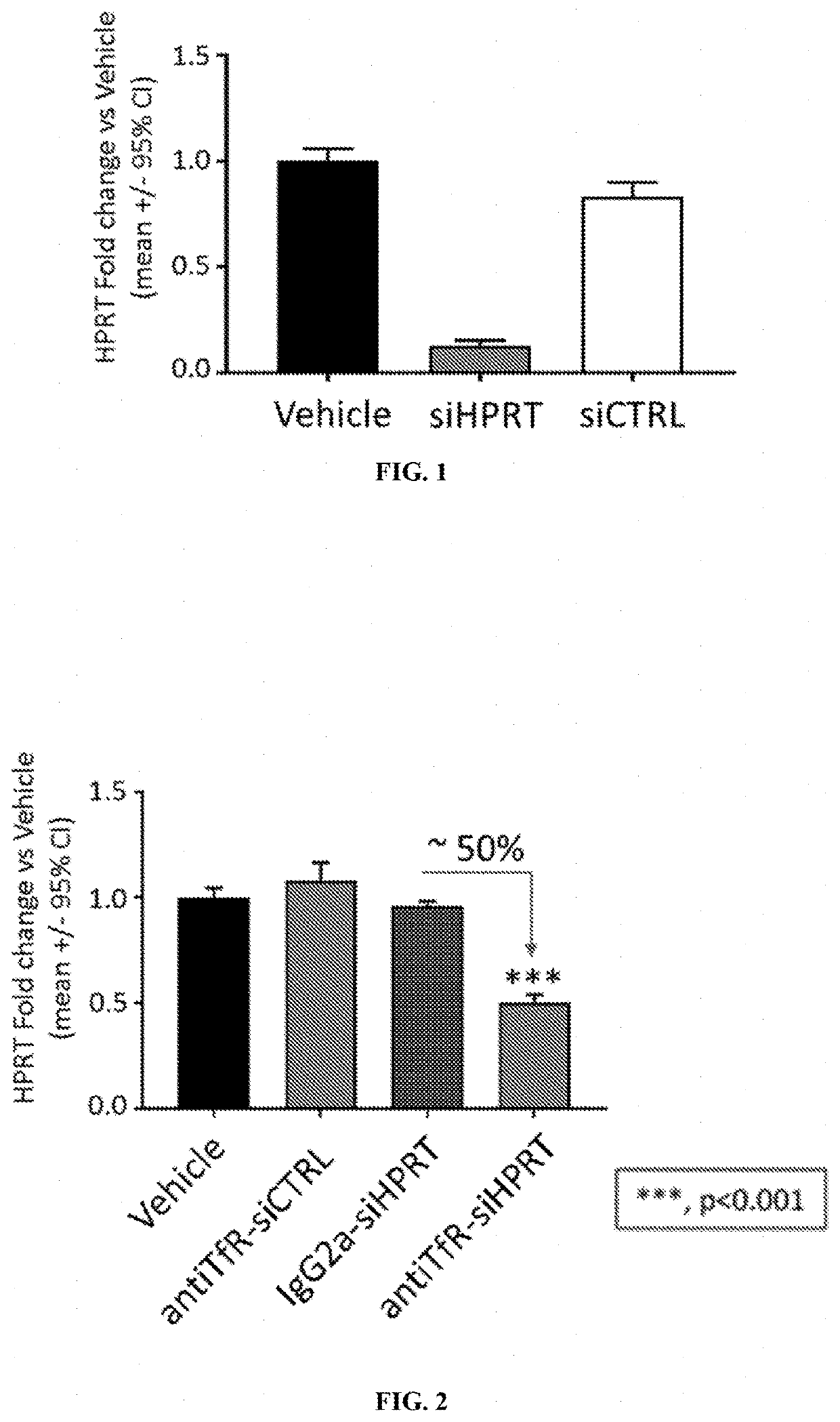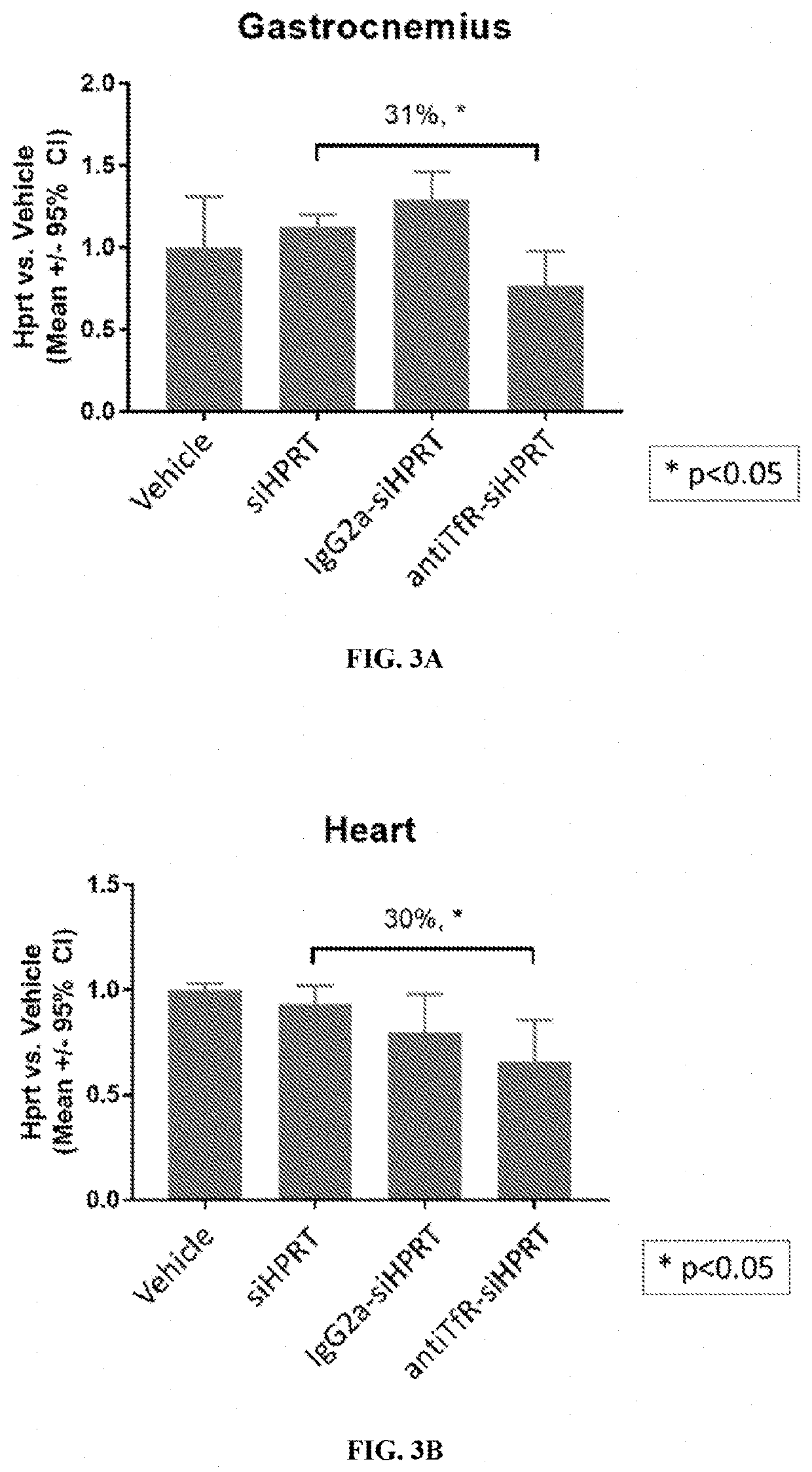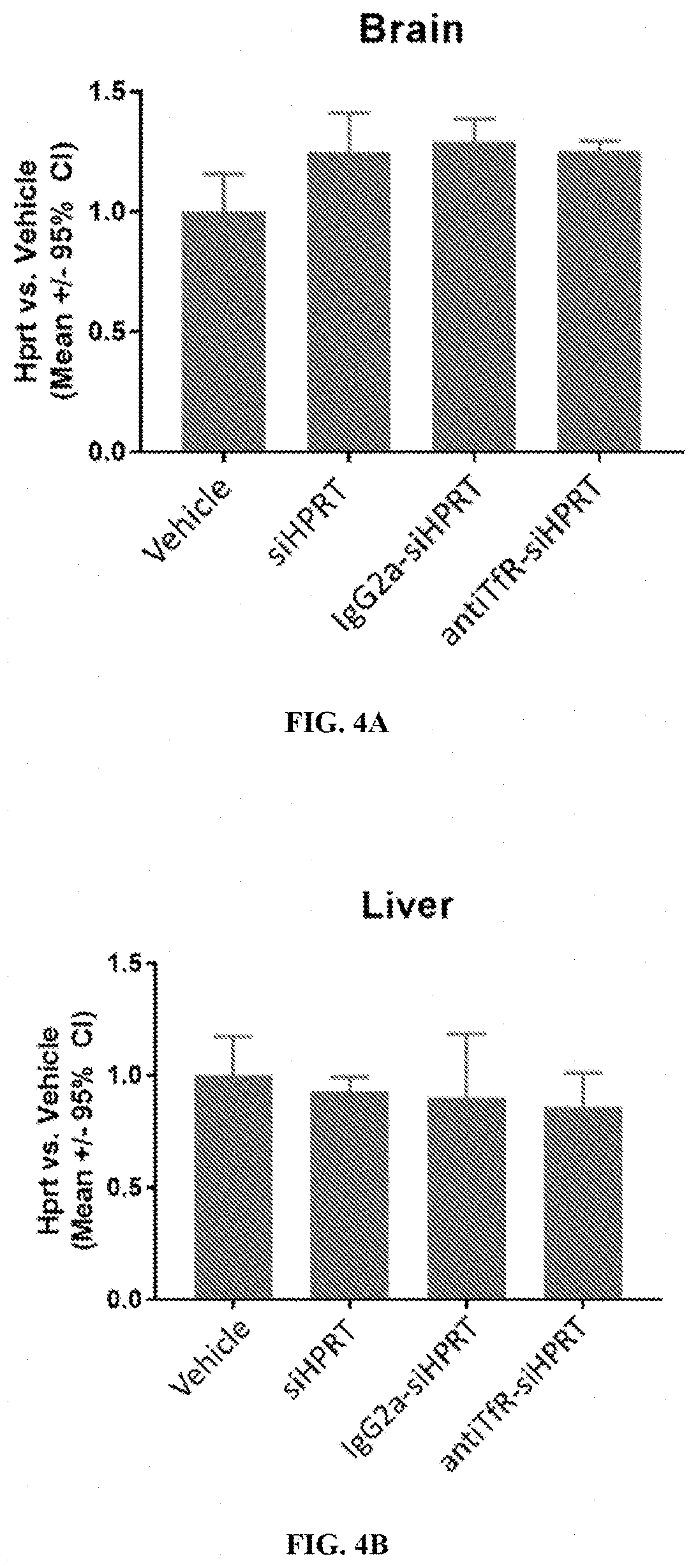Muscle targeting complexes and uses thereof for treating pompe disease
a muscle and complex technology, applied in the field of muscle targeting complexes, can solve the problems of progressive muscle weakening symptoms of pd, toxic build-up of glycogen in lysosomes, and decrease in enzyme activity, so as to reduce glycogen levels, reduce glycogen levels, and reduce glycogen levels
- Summary
- Abstract
- Description
- Claims
- Application Information
AI Technical Summary
Benefits of technology
Problems solved by technology
Method used
Image
Examples
example 1
HPRT with Transfected Antisense Oligonucleotides
[0296]A siRNA that targets hypoxanthine phosphoribosyltransferase (HPRT) was tested in vitro for its ability to reduce expression levels of HPRT in an immortalized cell line. Briefly, Hepa 1-6 cells were transfected with either a control siRNA (siCTRL; 100 nM) or the siRNA that targets HPRT (siHPRT; 100 nM), formulated with lipofectamine 2000. HPRT expression levels were evaluated 48 hours following transfection. A control experiment was also performed in which vehicle (phosphate-buffered saline) was delivered to Hepa 1-6 cells in culture and the cells were maintained for 48 hours. As shown in FIG. 1, it was found that the HPRT siRNA reduced HPRT expression levels by ˜90% compared with controls.
TABLE 2Sequences of siHPRT and siCTRLSequencesiHPRT5′-UcCuAuGaCuGuAgAuUdUaU-(CH2)6NH2-3′sense strandsiHPRT5′-paUaAaAuCuAcAgUcAuAgGasAsu-3′antisensestrandsiCTRL5′-UgUaAuAaCcAuAuCuAcCuU-(CH2)6NH2-3′sense strandsiCTRL5′-aAgGuAgAuAuGgUuAuUaCasAsa-3′...
example 2
HPRT with a Muscle-Targeting Complex
[0297]A muscle-targeting complex was generated comprising the HPRT siRNA used in Example 1 (siHPRT) covalently linked, via a non-cleavable N-gamma-maleimidobutyryl-oxysuccinimide ester (GMBS) linker, to DTX-A-002, an anti-transferrin receptor antibody.
[0298]Briefly, the GMBS linker was dissolved in dry DMSO and coupled to the 3′ end of the sense strand of siHPRT through amide bond formation under aqueous conditions. Completion of the reaction was verified by Kaiser test. Excess linker and organic solvents were removed by gel permeation chromatography. The purified, maleimide functionalized sense strand of siHPRT was then coupled to DTX-A-002 antibody using a Michael addition reaction.
[0299]The product of the antibody coupling reaction was then subjected to hydrophobic interaction chromatography (HIC-HPLC). antiTfR-siHPRT complexes comprising one or two siHPRT molecules covalently attached to DTX-A-002 antibody were purified. Densitometry confirmed...
example 3
HPRT in Mouse Muscle Tissues with a Muscle-Targeting Complex
[0302]The muscle-targeting complex described in Example 2, antiTfR-siHPRT, was tested for inhibition of HPRT in mouse tissues. C57BL / 6 wild-type mice were intravenously injected with a single dose of a vehicle control (phosphate-buffered saline); siHPRT (2 mg / kg of RNA); IgG2a-siHPRT (2 mg / kg of RNA, corresponding to 9 mg / kg antibody complex); or antiTfR-siHPRT (2 mg / kg of RNA, corresponding to 9 mg / kg antibody complex. Each experimental condition was replicated in four individual C57BL / 6 wild-type mice. Following a three-day period after injection, the mice were euthanized and segmented into isolated tissue types. Individual tissue samples were subsequently assayed for expression levels of HPRT (FIGS. 3A-3B and 4A-4E).
[0303]Mice treated with the antiTfR-siHPRT complex demonstrated a reduction in HPRT expression in gastrocnemius (31% reduction; p<0.05) and heart (30% reduction; p<0.05), relative to the mice treated with the...
PUM
| Property | Measurement | Unit |
|---|---|---|
| equilibrium dissociation constant | aaaaa | aaaaa |
| Tm | aaaaa | aaaaa |
| Tm | aaaaa | aaaaa |
Abstract
Description
Claims
Application Information
 Login to View More
Login to View More - R&D
- Intellectual Property
- Life Sciences
- Materials
- Tech Scout
- Unparalleled Data Quality
- Higher Quality Content
- 60% Fewer Hallucinations
Browse by: Latest US Patents, China's latest patents, Technical Efficacy Thesaurus, Application Domain, Technology Topic, Popular Technical Reports.
© 2025 PatSnap. All rights reserved.Legal|Privacy policy|Modern Slavery Act Transparency Statement|Sitemap|About US| Contact US: help@patsnap.com



